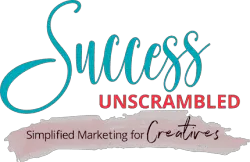Podcast: Play in new window | Download (Duration: 23:18 — 32.7MB) | Embed
Subscribe: Spotify | Amazon Music | Email | TuneIn | Deezer | RSS | More
Linda was excited, she figured out her course niche but how to create a course outline still remained as the burning question on her lips.
You see, Linda spent the last 3-5 years trying to decide what she can teach online.
As a Therapist, it can be difficult to translate her skills into something easily teachable.
Like Linda, I’ve had similar battles in the past.
At this point, I’ve already lost count of how many courses I prematurely tossed aside.
You know the ones I’m talking about: those with huge unstructured walls of text that’s just a huge run-on sentence.
I can’t tell you how frustrating it is to try and learn a new course that’s nothing more than a jumble of information. How are you supposed to know where to start? Or what the most important information is?
Fortunately, a simple solution to this problem is learning how to create a course outline.
A course outline is a road map for your course. It’s a way to take all the information you want to include in your course and organize it into an easy-to-follow format.
Now, how do you create an online course outline?
Creating a course outline is a simple process that anyone can do. Determine your goals, break down the steps, and reassess your outline, ensuring you maintain simplicity.
In this blog post, you’ll learn easy steps (with examples) to create an effective course outline. I’ll also give you outline creation tips and answer questions like, “what is a course format?”
Let’s take a closer look.

What is a Course Outline?
Did you know that 2030 e-learning predictions place the online course market at six times the 2015 levels($107 billion)?
As such, it’s unsurprising why many want to perfect this area. One of the biggest questions course creators ask is, “What is a detailed course outline?”
A course outline is a document that typically includes a
- Course title
- Course description,
- Learning outcomes
- Subject matter topics
- Course syllabus materials
- Course requirements and assessments
- Course Policies
- Course Schedule
- Instructor’s contact information, and sometimes social media pages.
A course outline is like a teaching partner for instructors, which lays the building blocks for each online course topic. You can share it with students to give them an overview of the course content.
Once a course plan is ready, you may add more detail to the objectives or topics or an additional assessment. You can also modify a course plan as you teach to make changes to the content or structure of the course.
Why You Need a Course Outline
An outline is an excellent enhancer of your teaching methods.
It helps you organize yourself and stay on the right track. An outline helps you keep all your content organized in one place from the first to the final project. You can easily reference it when you need to and it can help you with course development.
An outline also helps ensure an instructional designer creates cohesive and well-flowing modules. Planning your course material ahead of time ensures that the component parts build on each other. It ensures that you adequately cover all the course modules.
Creating an outline for your course may seem time-consuming and hard work. However, it saves you much time in the long run. Take time to plan out your content ahead of time. This way, you’ll avoid having to make last-minute changes to your lectures or handouts.
A course outline provides a clear overview of the learning resources and their structure. A clear understanding is helpful to prospective students as they meet your material for the first time.
Well-structured course outlines give a good impression to students. They help them determine how the courses fit into their schedules and what the set expectations are.
How To Create an Effective Course Outline
Creating a course outline can be a simple or complex process, depending on your needs. You can create an outline in a word processing program like Microsoft Word, Airtable or Google Docs. You can also use an online course outline template.
The three aspects to keep in mind when creating an outline are goals, procedures, and assessing the product.

First Step: Determine Your End Goal
The first step is establishing the course goals. What do you want your course students to achieve by the end of the course?
Your learning objectives should be SMART. In other words, it should be a goal you can realistically achieve within a specific timeframe.
For example, if you want your students to learn how to use a particular software program, your goal should be
- Specific: learn how to use the software program
- Measurable: Use the software program to complete a specific task
- Achievable: have the necessary skills and knowledge to use the software program
- Relevant: the software program is relevant to your course
- Time-bound: You’ll complete the task within a specific timeframe.
Once you determine your end goal, you can begin to identify the steps that you’ll need to take to reach it.
Next Step: Identify Your Steps
The next step in creating an effective course outline is to identify the steps needed to take to reach your goal. This stage may require some research on your part, but it is important to ensure that your steps are clear and concise.
To identify your steps, you’ll need to think about what your target audience needs to do to reach your goal. For example, if your goal is for your students to learn how to use a particular software program, your steps might include
- Research the software program.
- Install the software program.
- Learn the basics of how to use the software program.
- Complete a specific task using the software program.
- Evaluate their progress and understanding of how to use the software program.
- Repeat steps 4 and 5 until they have a complete understanding of how to use the software program.
Once you have identified your steps, you can begin to outline your course.
Final Step: Review Your Outline
The final step is to ensure that each step is well-defined. There should be a logical progression covering everything from the basic information at the start until the end of the course.
If there are steps that are not vital, remove them from your outline. It’s also a good idea to ask yourself if the order of the steps makes sense. Let the first things ease students into your course and follow smoothly to the end.
Tips When Creating Your Course Outline
Many first-time course creators make the mistake of rushing through the content creation process. As a result, their courses end up disorganised and difficult to follow.
A great way to ensure your course outline is on par is to be concise yet detailed. Here are a few tips to help you get started.
Use as Few Steps as Possible
The best way to create a course outline is to use as few steps as possible. Doing this helps to keep your course concise and focused. Too many steps can overwhelm students and make it difficult for them to follow along.
Additionally, be clear and brief when writing your steps. Use language that your target audience understands and can follow easily.

Use Supplementary Information Sparingly
Don’t load your students with handouts, PowerPoints, and readings. Too much supplemental information can overwhelm students and make it difficult for them to focus on the content of your course.
Only include the necessary information to make the students’ understanding a little bit better. Everything added should help your students to understand the course’s lessons and improve their learning.
Use Simple Language
Imagine trying to teach peripheral nerve surgery in elementary school. It would be pretty difficult, right? That’s because the language used in medical school is far too complex for elementary school students.
The same is true when creating your course outline. Don’t complicate basic details except when handling complex subjects with no alternatives.
Simple language helps to ensure that your online students understand the material and can follow along easily. Additionally, simple language helps keep your material focused and concise, two key things of successful courses.
Course Outline Example
Have you gone through the outline creation steps but still wondering, “How do I create a course plan?” While we’ll follow our three steps, we can break them further into five tasks. We’ll:
- Start with the result. Write down the result using mind map tools like MindMeister and Coggle. You can also use tools with cards, boards, and lists like Trello. A third option would be merging several tools, such as mind-mapping and building further on Trello.
- Determine your major steps. Don’t get into many details. We are only outlining. For instance, creating several Trello lists of the key steps needed to achieve the result.
- Develop the action steps for each major step. Provide the subordinate steps for each step you developed above. Don’t get into details.
- Outline the milestones covering each of your steps in step three. Get into the nitty-gritties to ensure you address all the critical information, i.e.; you can make checklists for each step with Trello, Airtable or Google Sheets.
- Review your outline. Drag and adjust to ensure everything flows and is cohesive.
Let’s now apply the simplified version to see a course outline example.
Application of Steps
Let’s assume our course title is “How to Start a Blog.” We’ll begin with the result and work our way backwards.
So, the goal of each student learning in this class is to “become a blogger.”
There are several major steps involved in starting a blog, which we can break down into lists inside Asana, ClickUp or Notion.
We’ll have several topics. For instance, the main topic that can form our first module could be the “blog framework.” Under this, some major steps may include:
- Choosing a blog name
- Creating a blog navigation layout
- Buying a domain and hosting.
You need to take several steps for all major steps in starting a blog. For instance, when choosing a blog name, you’ll need to:
- Brainstorm ideas
- Come up with a list of possible names
- Decide on the best one.
When creating a blog navigation layout, you’ll need to:
- Determine what pages you want to include
- Establish how you want those pages organized.
Then, when buying a domain and hosting, you’ll need to:
- Research your options
- Decide on a provider
- Set up your account.
You must meet several milestones for each action step in starting a blog. For instance, when brainstorming ideas for a blog name, you may need to:
- Assess your niche
- Come up with a list of relevant keywords
- Use keywords to generate a list of possible names.
When deciding the name, milestones may include:
- Establishing a weighting mechanism for various factors
- Using the weighting mechanism to assess options
- Selecting the best option.
As we conclude, you’ll want to ensure that the steps involved in each major task are clearly laid out.
By the end, you’ll have an effective course outline. Readers/students should have all they need to become successful bloggers.

Conclusion
A course outline is a vital element of the learning management system. It makes it easy to identify important pieces within your training materials.
The most important thing course instructors should do for a great course is careful planning. Try using headings, subheadings, audio recordings, and video content to break up your content and make it easy to scan.
I hope our course outline template provided you with everything you need to create a successful online course outline, right?
You can use this example to tailor it to your specific course and stand out from similar courses.
If you want an excellent platform to create online courses, grab our free course outline template here. My 6-figure clients use a similar template for their courses.
This course gives you excellent tips on actualizing your goals through writing.
If you need help mapping out or launching your course feel free to book some time in my calendar here.


